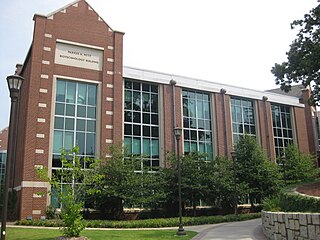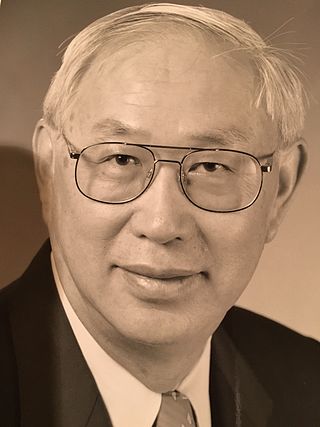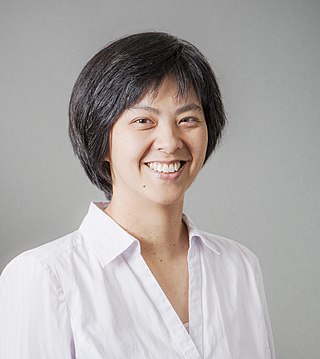Related Research Articles

The Wallace H. Coulter Department of Biomedical Engineering is a department in the Emory University School of Medicine, Georgia Institute of Technology's College of Engineering, and Peking University College of Engineering dedicated to the study of and research in biomedical engineering, and is named after the pioneering engineer and Georgia Tech alumnus Wallace H. Coulter. The graduate program has consistently ranked 2nd in USNWR rankings, while the undergraduate program ranks 1st in USNWR rankings.
Kyriacos A. Athanasiou is a Greek Cypriot-American bioengineer who has contributed significantly to both academic advancements as well as high-technology industries. He is currently a Distinguished Professor at the University of California, Irvine. He joined UCI from the University of California, Davis where he also served as the Chair of the Biomedical Engineering department. Before joining the University of California in 2009, he was the Karl F. Hasselmann Professor at Rice University. He has published hundreds of scientific articles detailing structure-function relationships and tissue engineering approaches for articular cartilage, the knee meniscus, and the temporomandibular joint.

The American Institute for Medical and Biological Engineering (AIMBE) is a non-profit organization founded in 1991, and headquartered in Washington. It represents 50,000 medical and biomedical engineers, and academic institutions, private industry, and professional engineering societies.

Van C. Mow is a Chinese-born-American bioengineer, known as one of the earliest researchers in the field of biomechanics.
Robert M. Nerem, often referred to as Bob Nerem, a member of the U. S. National Academy of Engineering and the Institute of Medicine, held the Parker H. Petit Distinguished Chair for Engineering in Medicine and Institute Professor Emeritus at the Georgia Institute of Technology where he was an Emeritus Professor until his death.

Ravi V. Bellamkonda is an Indian-American biomedical engineer and academic administrator. Since 2021, he has served as Provost and Executive Vice President for Academic Affairs at Emory University in Atlanta, Georgia. Bellamkonda was previously Vinik Dean of the Pratt School of Engineering at Duke University.

Ellis Meng is the Shelly and Ofer Nemirovsky Chair of Convergent Biosciences and Professor of Biomedical Engineering and Electrical and Computer Engineering in the Viterbi School of Engineering at the University of Southern California, where she also serves as the Vice Dean of Technology Innovation and Entrepreneurship. Meng is highly decorated in the development of novel micro- and nanotechnologies for biomedical applications. In 2009, Meng was named on MIT Technology Review's "Innovators Under 35" List for her work on micropumps that deliver drugs preventing blindness, and she was listed on the 40 Under 40 List of the Medical Device and Diagnostic Industry (MDDI) in 2012.
Karmella Ann Haynes is a biomedical engineer and associate professor at the Wallace H. Coulter Department of Biomedical Engineering, Georgia Institute of Technology and Emory University. She researches how chromatin is used to control cell development in biological tissue.

Jonathan S. Lewin is an American neuroradiologist specializing in medical imaging research with an emphasis on the investigation, development, and translation of new magnetic resonance imaging (MRI) techniques. He is the former executive vice president for health affairs (EVPHA) and executive director of the Woodruff Health Sciences Center for Emory University, and former President, CEO, and chairman of the board of Emory Healthcare. He currently serves as professor of radiology, biomedical engineering, and neurosurgery in the Emory School of Medicine and as professor of health policy and management in the Rollins School of Public Health.
Beth Ann Winkelstein is the Deputy Provost and the Eduardo D. Glandt President’s Distinguished Professor at the University of Pennsylvania. Winkelstein has established an active research program that is recognized for elucidating the mechanisms of subfailure cervical spine injuries and the cellular events surrounding the etiology of chronic pain. She is further recognized for longstanding contributions to the discipline of biomechanics and for mentoring many students that have followed into research active careers. Her research focuses on orthopaedic and musculoskeletal disorders, including developing innovative new pharmacological treatments and biomedical devices; the mechanisms of bodily injury, especially injuries from sports, automobile accidents, and/or degenerative diseases; and new treatments for spine and other joint injuries.
David Harold Frakes is an American engineer, professor, and entrepreneur. He is a Distinguished Faculty Fellow in biomedical engineering at the Georgia Institute of Technology. He is also an adjunct professor of radiology at Mayo Clinic. Frakes is best known for pioneering simulation-based planning for brain surgeries and 3D printing-based planning for heart surgeries.
Lucas H. Timmins is an American biomedical engineer and currently an associate professor at Texas A&M University. He is active in the fields of computational and experimental biomechanics and the application of these research domains to address prevalent challenges in cardiovascular medicine.
Manu Omar Platt is an American biomedical engineer serving as the director of the NIH Biomedical Engineering Technology Acceleration (BETA) center. He also serves as NIBIB Associate Director for Scientific Diversity, Equity and Inclusion.
Ellen Marie Arruda is an American mechanical engineer known for her research on the mechanical properties of polymers and on tissue engineering, with applications including the design of improved football helmets, artificial tooth enamel that can withstand high-shock and high-vibration environments, and nanolayered composite materials that are lightweight, as strong as steel, and transparent. The Arruda–Boyce model for the behavior of rubber-like polymers is named for her and her doctoral advisor Mary Cunningham Boyce, with whom she published it in 1993. She is Maria Comninou Collegiate Professor of Mechanical Engineering and Tim Manganello / Borg Warner Department Chair of Mechanical Engineering at the University of Michigan.

Lakiesha Williams is a biomedical engineer and an Associate Professor at the University of Florida. Williams specializes in traumatic brain injury and biomechanics. Specifically, her work involves the modelling and mechanics of soft tissue, and how outside influences affect their structure. Much of her work on repetitive brain trauma involves utilizing preclinical models to study the long term neurodegenerative effects of damages. She grew up in New Orleans, with her dad working as a carpenter. Williams went on to become a first generation college student, college graduate, and now, an Associate Professor.
Flaura Ann Koplin Winston is an American pediatrician and engineer. She was one of the first to identify the first case of airbag-associated child death and her research and advocacy have led to drafting new federal airbag policies.
Michele J. Grimm is a British-American biomechanical engineer. She took on the role of Dean of the College of Engineering and Applied Sciences at the University at Albany in 2022. She was previously the Wielenga Creative Engineering Endowed Professor of mechanical engineering and biomedical engineering at Michigan State University. Her research concerns the biomechanics of injury, particularly injuries in newborn children to the brachial plexus, a part of the nervous system connecting it to the upper body.
Dawn M. Elliott is an American biomedical engineer whose research concerns the biomechanics of connective tissue including the tendons, menisci, and intervertebral discs. She is Blue and Gold Distinguished Professor of Biomedical Engineering at the University of Delaware, adjunct professor of orthopaedic surgery at the Perelman School of Medicine at the University of Pennsylvania, and the former president of the Biomedical Engineering Society.
Brittany Coats is an American biomechanical engineer whose research is centered on head injuries, especially in infants. She is a professor of mechanical engineering at the University of Utah, and the director of the Utah Head Trauma Lab.
May Dongmei Wang is a Chinese-American biomedical engineer whose research involves biomedical big data analytics, the interpretation and application of big data in medicine and biology, as generated from microarrays and quantum dots. She is a professor of biomedical engineering and Wallace H. Coulter Distinguished Faculty Fellow in the Wallace H. Coulter Department of Biomedical Engineering, a joint program of Georgia Tech, Emory University, and Peking University.
References
- ↑ "NSF selects Susan S. Margulies to head the Engineering Directorate". www.nsf.gov. Retrieved 2021-10-24.
- ↑ "New chair named for Coulter Department of Biomedical Engineering". 22 May 2017.
- 1 2 3 "Meet New Chair Susan Margulies". Coulter Department of Biomedical Engineering at Georgia Tech and Emory University. Retrieved 2018-05-14.
- 1 2 "Honors: GSE, SSW, SEAS, Publications, Solomon Labs, Honorary Degrees". almanac.upenn.edu. Retrieved 2018-05-14.
- 1 2 3 "Stopping the leak in the pipeline: Dr. Susan Margulies on her career path and work towards equality in academia". Beta Pleated Chic. Retrieved 2018-05-14.
- ↑ Margulies, Susan Sheps (1987). Biomechanics of traumatic coma in the primate (head injury) (Thesis). University of Pennsylvania.
- 1 2 "Susan Margulies | Introductions Necessary". introductionsnecessary.com. Retrieved 2018-05-14.
- ↑ "Injury Biomechanics Lab Homepage". www.seas.upenn.edu. Retrieved 2018-05-14.
- 1 2 "Research Directory Profile". Penn Engineering. Retrieved 2018-05-14.
- ↑ Margulies, Susan S.; Kilbaugh, Todd; Sullivan, Sarah; Smith, Colin; Propert, Kathleen; Byro, Melissa; Saliga, Kristen; Costine, Beth A.; Duhaime, Ann-Christine (May 2015). "Establishing a Clinically Relevant Large Animal Model Platform for TBI Therapy Development: Using Cyclosporin A as a Case Study". Brain Pathology (Zurich, Switzerland). 25 (3): 289–303. doi:10.1111/bpa.12247. PMC 4459790 . PMID 25904045.
- ↑ "Susan S Margulies". Center for Resuscitation Science, Perelman School of Medicine at the University of Pennsylvania. Retrieved 2018-05-14.
- ↑ "cmbbe2016.com: Prof. Susan Margulies". cmbbe2016.com. Retrieved 2018-05-14.
- ↑ "Dr. Susan S. Margulies Joins Astrocyte Pharmaceuticals' Scientific Advisory Board - Astrocyte Pharmaceuticals". Astrocyte Pharmaceuticals. 2015-07-16. Retrieved 2018-05-15.
- ↑ "Susan Margulies Named Chair and Eminent Scholar". American Physiological Society. Retrieved 2018-05-14.
- ↑ "New Chair Named for Coulter Department of Biomedical Engineering at Georgia Tech and Emory University". Coulter Department of Biomedical Engineering at Georgia Tech and Emory University. Retrieved 2018-05-14.
- ↑ "Grantome: Search". Grantome. Retrieved 2018-05-14.
- ↑ "Dr. Susan S. Margulies". NAE Website. Retrieved 2021-06-08.
- 1 2 "National Academy of Medicine Elects 100 New Members". National Academy of Medicine. 2020-10-19. Retrieved 2021-06-08.
- 1 2 3 4 5 6 7 8 Canada, The 3rd Biennial Conference on Brain Injury in Children July 9–11, 2013 - Toronto. "Dr. Margulies obtained her BSE in Mechanical and Aerospace Engineering from Princeton University, and her PhD in Bioengineering from University of Pennsylvania". www.sickkids.ca. Retrieved 2018-05-14.
{{cite web}}: CS1 maint: multiple names: authors list (link) CS1 maint: numeric names: authors list (link) - ↑ "Past Fellows". The Mortimer and Raymond Sackler Institute of Advanced Studies, TAU. Retrieved 2018-05-14.
- ↑ "Dr. Susan S. Margulies". NAE Website. Retrieved 2020-06-18.
- ↑ "New members". American Academy of Arts and Sciences. 2023. Retrieved 2023-04-21.